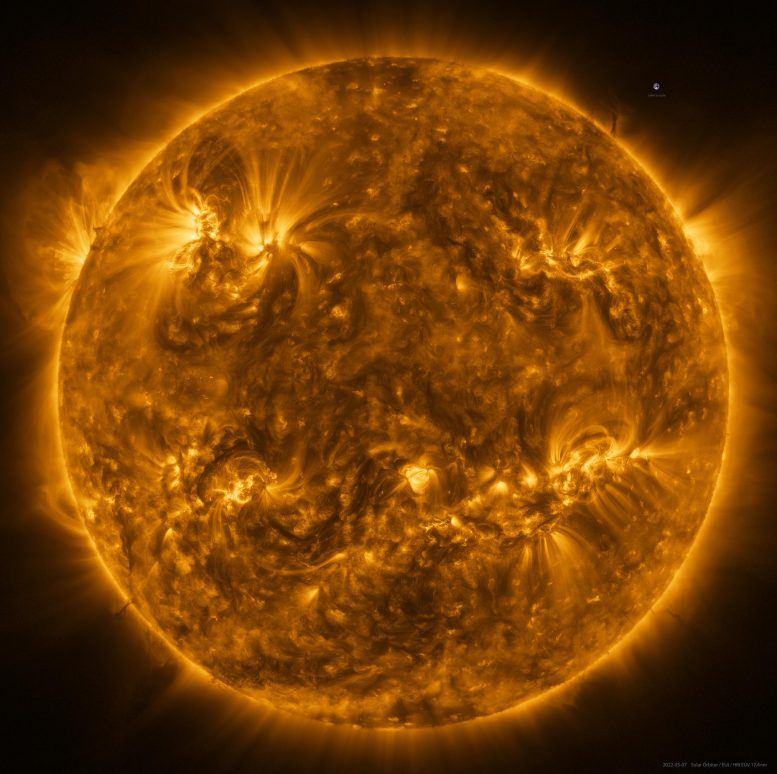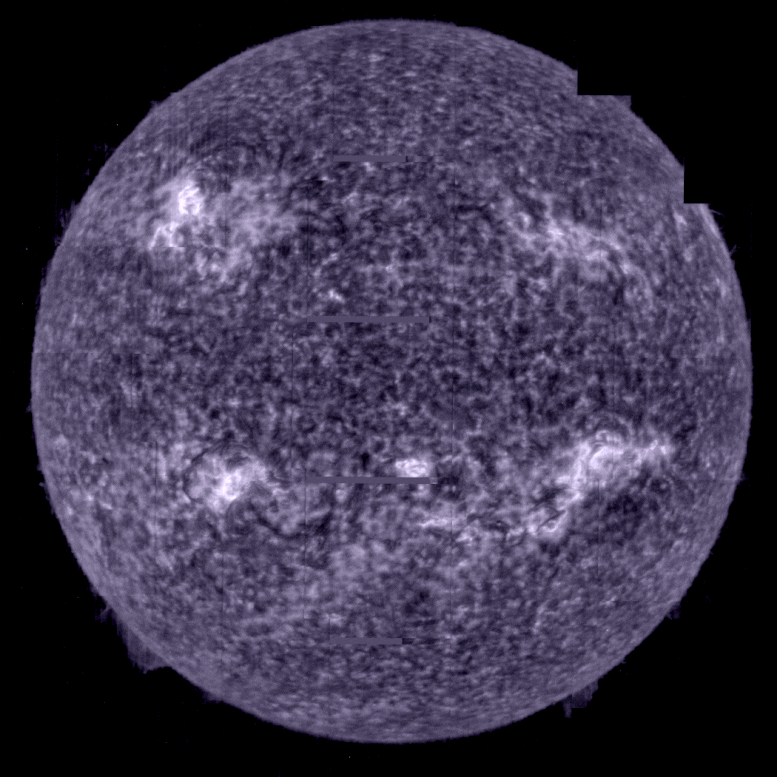

Animación del Solar Orbiter de la Agencia Espacial Europea. Crédito: ESA/Medialab
Las últimas imágenes de Solar Orbiter muestran el sol completo con un detalle sin precedentes. Fue tomada el 7 de marzo de 2022, cuando la nave espacial transitaba directamente entre la Tierra y el Sol.
Una de las imágenes capturadas por Extreme Ultraviolet Imager (EUI) es la imagen de mayor resolución jamás tomada del disco solar completo y la atmósfera exterior, la corona.
Otra imagen tomada por el instrumento Spectral Imaging of the Coronal Environment (SPICE) representa la primera imagen completa del Sol en 50 años, y la mejor imagen tomada a lo largo de la longitud de onda Lyman beta de radiación ultravioleta emitida por gas hidrógeno.
Las imágenes fueron tomadas cuando el orbitador solar se encontraba a unos 75 millones de kilómetros de distancia, a medio camino entre nuestro mundo y su estrella madre. El telescopio de alta resolución de EUI captura imágenes con una resolución espacial tan alta que, a esa distancia cercana, se requiere un mosaico de 25 imágenes individuales para cubrir todo el Sol. Tomada una por una, la imagen completa se tomó durante un período de más de cuatro horas porque cada pieza tarda unos 10 minutos, incluido el tiempo que tarda la nave espacial en señalar de una parte a la siguiente.

El Sol visto por el Solar Orbiter en luz ultravioleta extrema desde una distancia de aproximadamente 75 millones de km. La imagen es un mosaico de 25 imágenes individuales tomadas el 7 de marzo de 2022 por el Telescopio de Alta Resolución del Instrumento de Imagen Ultravioleta (EUI). Esta imagen fue tomada en una longitud de onda de 17 nanómetros, en la región ultravioleta extrema del espectro electromagnético, revelando la atmósfera superior del sol, la corona, que tiene una temperatura de alrededor de un millón de grados centígrados. También se incluye una imagen de la Tierra de la escala en la posición de las 2. Crédito: ESA y NASA/Solar Orbiter/Equipo EUI; Procesamiento de datos: E. Kraaikamp (ROB)
En total, el imagen final Contiene más de 83 millones de píxeles en una cuadrícula de 9148 x 9112 píxeles. A modo de comparación, esta imagen tiene una resolución diez veces mejor que la que puede mostrar una pantalla de TV 4K.
EUI representa el Sol en una longitud de onda de 17 nanómetros, en la región ultravioleta extrema del espectro electromagnético. Esto revela la atmósfera superior del sol, la corona, que tiene una temperatura de alrededor de un millón de grados.[{» attribute=»»>Celsius.

Solar Orbiter took images of the Sun on March 7, from a distance of roughly 75 million kilometres, using its Spectral Imaging of the Coronal Environment (SPICE) instrument. SPICE takes simultaneous “spectral images” at several different wavelengths of the extreme ultraviolet spectrum by scanning its spectrometer slit across a region on the Sun. The different wavelengths recorded correspond to different layers in the Sun’s lower atmosphere. Purple corresponds to hydrogen gas at a temperature of 10,000°C, blue to carbon at 32,000°C, green to oxygen at 320,000°C, yellow to neon at 630,000°C. Each full-Sun image is made up of a mosaic of 25 individual scans. It represents the best full Sun image taken at the Lyman beta wavelength of ultraviolet light that is emitted by hydrogen gas. Credit: ESA & NASA/Solar Orbiter/SPICE team; Data processing: G. Pelouze (IAS)
At the 2 o’clock (near the image of the Earth for scale) and 8 o’clock positions on the edges of the Sun, dark filaments can be seen projecting away from the surface. These ‘prominences’ are prone to erupt, throwing huge quantities of coronal gas into space and creating ‘space weather’ storms.
In addition to EUI, the SPICE instrument was also recording data during the crossing. These too needed to be pieced together as a mosaic.
SPICE is designed to trace the layers in the Sun’s atmosphere from the corona, down to a layer known as the chromosphere, getting closer to the surface. The instrument does this by looking at the different wavelengths of extreme ultraviolet light that come from different atoms.

Taking the Sun’s temperature. Credit: ESA & NASA/Solar Orbiter/SPICE team; Data processing: G. Pelouze (IAS)
In the SPICE sequence of images purple corresponds to hydrogen gas at a temperature of 10,000°C, blue to carbon at 32,000°C, green to oxygen at 320,000°C, yellow to neon at 630,000°C.
This will allow solar physicists to trace the extraordinarily powerful eruptions that take place in the corona down through the lower atmospheric layers. It will also allow them to study one of the most puzzling observations about the Sun: how the temperature is rising through the ascending atmospheric layers.
Usually the temperature drops as you move away from a hot object. But above the Sun, the corona reaches a million degrees Celsius whereas the surface is only about 5000°C. Investigating this mystery is one of the key scientific objectives of Solar Orbiter.
The images were taken on 7 March, precisely when Solar Orbiter crossed the Sun-Earth line, so the images can be compared with Earth-bound solar instruments and cross-calibrated. This will make it easier to compare results from different instruments and observatories in future.
On March 26, Solar Orbiter reaches another mission milestone: its first close perihelion. The spacecraft is now inside the orbit of Mercury, the inner planet, taking the highest resolution images of the Sun it can take. It is also recording data on the solar wind of particles that flows outwards from the Sun.
And this is just the start, over the coming years the spacecraft will repeatedly fly this close to the Sun. It will also gradually raise its orientation to view the Sun’s previously unobserved polar regions.
Solar Orbiter is a space mission of international collaboration between ESA and NASA.






More Stories
¿Cómo se hicieron los agujeros negros tan grandes y rápidos? La respuesta está en la oscuridad.
Una vaca marina prehistórica fue devorada por un cocodrilo y un tiburón, según los fósiles
El lanzamiento del cohete Falcon 9 de SpaceX se ha detenido a medida que se acercan dos importantes misiones de vuelos espaciales tripulados.